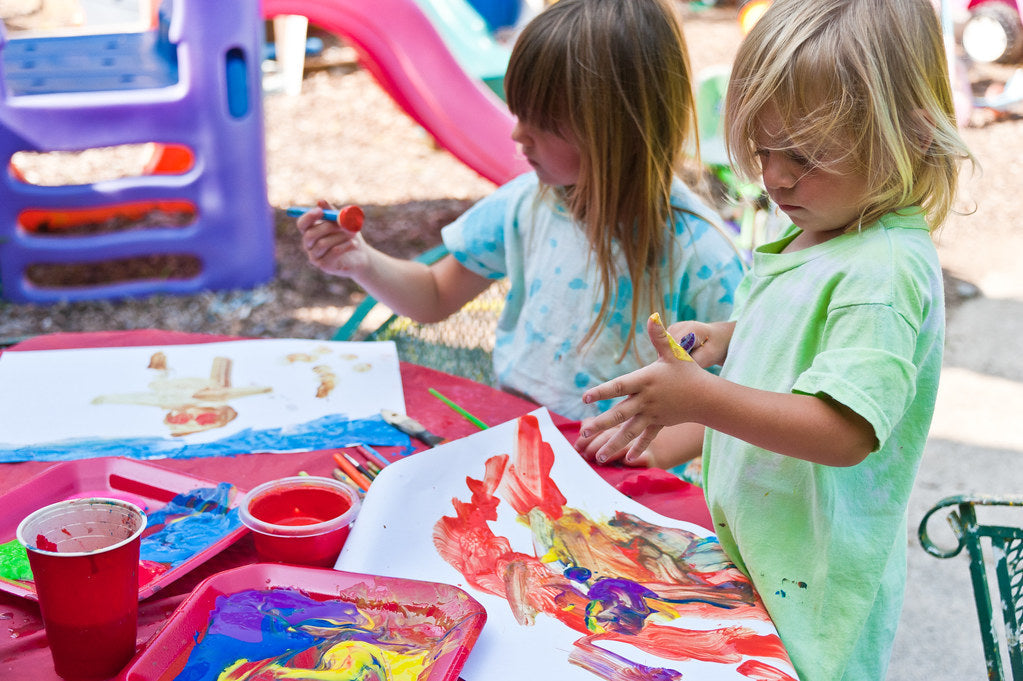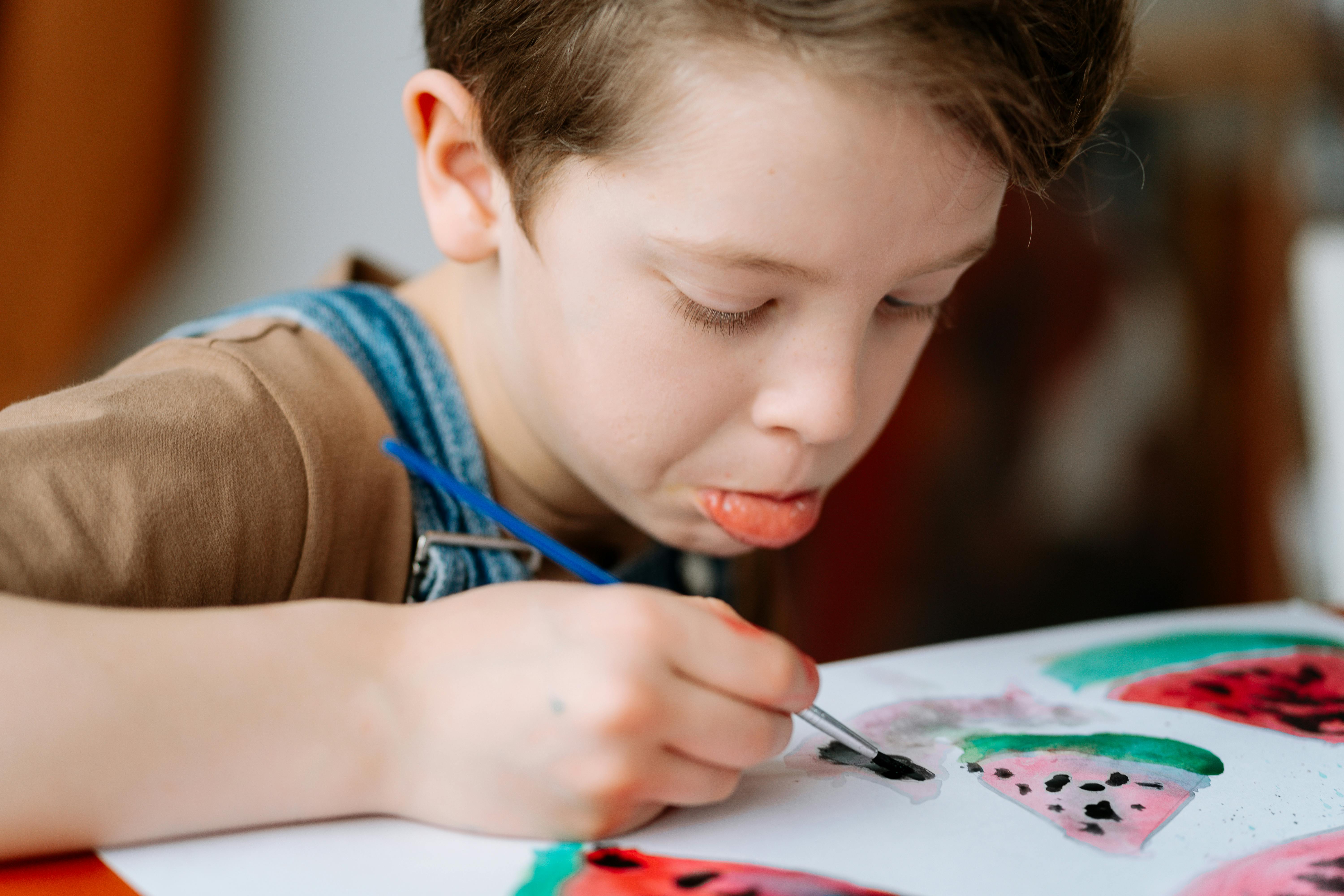
Tips for Art Projects for Neurodivergent Children
My nephew, Oliver, shies away from drawing anything realistic. He prefers to draw abstract designs. As a perfectionist, he fears his realistic drawings won’t be perfect. But he loves drawing. It gives him great pleasure, and he’s learned to deal with his perfectionism.
Another child in my life, Morgan, rushes through drawing activities with a haphazard approach because she lacks patience and focus. While both kids are on the Autism spectrum, (more broadly they are neurodivergent or neurodivergent,) they couldn’t be more different.
We humans are a neuro-diverse species. We all have our unique gifts and challenges. Art engages children’s senses and supports their development in amazing ways that enhance cognitive, social-emotional growth, and multi-sensory learning, but some kids can have extra challenges engaging in art projects.
Dealing with Your Child’s Perfectionism
Many of us have perfectionist tendencies and in some neurodivergent children, perfectionism is heightened. Perfectionists typically have unrealistically high expectations for themselves. When they do not meet them, it can lead to frustration, low self-esteem, anxiety, and depression.
If you’re noticing that your child has perfectionist tendencies, try these tips:
- Don’t show one example of what the project should look like. Instead, focus on technique, show them multiple examples, and then let them decide what their artwork should look like, without trying to live up to an example.
- Focus on the process rather than the final product. You can do art activities that aren’t meant to produce a finished work of art. You are just trying different techniques or playing with color.
- Encourage drawing and painting, and don’t require them to draw realistic images.
- Get a Buddha Board so that drawings fade away when they dry.
- Try working on a piece for a maximum of 20 minutes and then walking away or taking a break.
- Create art in a different setting than normal. Instead of coloring or painting where your child does their schoolwork, try an easel for a new perspective.
- Work on a piece together. This can be really freeing for some kids who are perfectionists but super stressful for others.
- If drawing or painting stresses your child out, try something totally different. A good example is making a 3-D sculpture with clay, paper mache, paper plates, boxes and other recycled containers, or cardboard.
- Your child may have trouble with transitions. My oldest son had a tough time in elementary school whenever he was forced to transition to a new activity before what he was working on was completed to his satisfaction. Keep art projects manageable and simple if you need to keep your child on a schedule.
- Focus on allowing your child to have independence. Art is freeform, and they can
Dealing with Your Child’s Lack of Patience
Many kids on the autism spectrum need to be aware of the sequence of events they should follow. Be as clear as possible about what you’ll do first, second, and third. Create a routine for whenever you do art together.
We like to begin by reading a book together on a sofa or floor. The book can be about an artist or time period, or perhaps the illustrations show the technique we’re learning that day. Reading together to begin is a way to connect with your child and set a context for the art project, which can be particularly important for some kids.
Then, you can put on your art aprons and proceed to a table where you have already set out the necessary supplies. Remove distractions and art supplies that you won’t be using. You may even want to create a poster with the steps written or drawn out.
For perfectionists, it can be good to avoid showing an example of what a project could look like, other kids may need more concrete examples.
Some kids need explicit instructions that break down directions into bite-sized chunks, modeling expectations, using visual clues, and discussing thinking processes.
Again, some kids have trouble with transitions. Give five and 10-minute warnings ahead of the transition. Setting a timer can be helpful so your child has a visual of how much time they have left for a project.
If your child tends to become overwhelmed easily, try these tips for approaching art projects for neurodivergent kids:
- Reduce unnecessary stimuli while maintaining structure and routine.
- Limit the choices of supplies; too many choices can be paralyzing. “Today we’re playing with watercolors.”
- Give them some structure for the project and then freedom within the structure. For example, instead of cutting paper with scissors, they can rip it to create unique shapes.
Tips for Art Supplies and Activities for Neurodivergent Children
There are many sensory experiences when creating art, including smells and textures. Anticipating a child’s sensory avoidance or sensory-seeking behaviors will help you be prepared. Engaging with art supplies tactilely may be a wonderful thing for your child, or it may be problematic. Some kids LOVE touching things – everything! Others HATE touching certain textures.

For Childern Who Love Textures
Some kids just love diving in and getting their hands dirty, whether with finger painting or clay modeling. There is something really magical about interacting with art supplies with our hands rather than a tool, like a brush. Here are some of our best tips for kids who love exploring textures with their hands:
- Our favorite supplies are water-soluble oil paints for finger painting. If they are decent quality, they should be buttery and oh-so satisfying! Just make sure that you aren’t using any pigments that are toxic. Check labels on paints before encouraging your kids to get them all over their hands. Some pigments have minerals in them that can be toxic and can go into your bloodstream through the skin, like cadmium, cobalt, manganese, chromium, and lead.
- Have your child paint on different surfaces. They can paint on mixed media paper, canvas, canvas boards, smooth wood boards, or Masonite.
- Put some boundaries around your art activity like: “The paint must stay on this table that is covered with plastic. You can use your hands as much as you want, but when you’re done, let me know so I can help you clean up.”
- Make sure that putting on an old shirt or apron, pushing sleeves up, and covering your table and floor are part of your routine every time, even when you aren’t using supplies that seem messy.
- Make sure your child knows the clear and simple process for cleaning hands before they touch something else (or each other). Also, water-soluble oils and acrylics wash off surfaces and clothes while they’re still wet, but once they dry, they’re permanent!
- Our favorite air-dry clay is Creative Paper Clay. It is non-toxic and easy to manipulate for little hands. For more about containing the mess, read our blog post, Want to Do Art With Your Kids But Afraid of the Mess?
For Children Who Dislike Textures
If your child experiences tactile defensiveness, certain materials or activities may cause them to go into sensory avoidance mode and refuse to participate. When my son was in early elementary school, he would rather go hungry than eat a messy sandwich that would get his hands dirty. Sticking his fingers in glue or paint was absolutely out of the question. For kids who dislike textures:
- Offer a variety of tools like brushes, cotton swabs, sponges, stamps, etc.
- Teach your child how to properly clean their tools so they can keep them usable for as long as possible.
- Since our brains process creativity differently when we’re using our hands rather than a tool, try giving them thin disposable gloves. The gloves can help your child manipulate the materials with their fingers without fear of getting messy.
- Smell the supplies before introducing them to your child. I’ve encountered kids who were preoccupied with how a specific product smelled and thus were unable to do the project at all. I never even noticed the odors, but they did and it greatly impacted their ability to participate.
- Some art suppliers intentionally add scents for fun, like fruit-scented markers. Even if these scents aren’t objectionable to your child, they could be very distracting!
When in doubt, stick to supplies that aren’t messy and don’t smell. Later, you can try adding one in from time to time, introducing different options slowly, and following your child’s lead.

Find out what your child finds joyful about art and do more of that! If they want to explore color and just paint entire sheets of paper with colors – go with it! In time, you may be able to encourage them to mix colors and try different techniques.
Perhaps your kid loves dinosaurs or machines. Try to incorporate these subjects into art-making. Art should be fun and include an element of play.
Show them lots of art. If your child is drawn to three-dimensional art, let him explore that. Provide a structure and a small selection of materials and then within the structure, let him experiment. Then, after the project is done, ask your child to tell you about their art to encourage reflection.
In the end, you know your kids best. No two children are exactly alike – but that’s what art is about, having the space to make something that is creative and individualistic.

